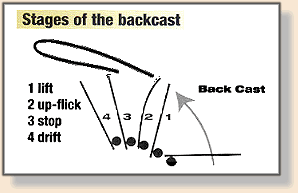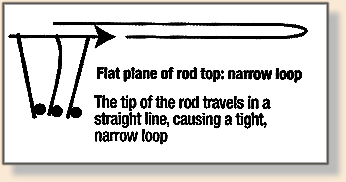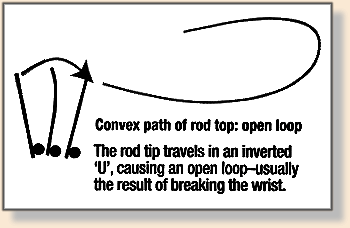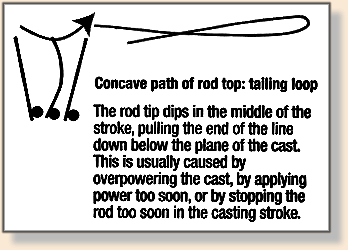The Absolute Beginner
Improving Casting Distance
By Bill Spicer
Most casters would love to get extra distance from their cast, but can't.
Let's face it, being able to cast farther can lead to more fish, especially when
you're fishing saltwater. If you've ever fished the Florida Keys and the tarpon
won't let you get close, or if you're fishing your favorite pond and the rise is
just a little too far out, you'll know how frustrating it can be.
As a beginner good basics are a must from the start. As an intermediate caster,
what you learned as a novice can be refined for more distance now. Bad casting
habits are what's holding you back now, and it's never too late to correct them.
The distance will come when you have corrected them.
Now, this might go against what you were originally taught, but it's time to forget
about the "clock settings" that you have read about in traditional casting manuals.
Casting from 11 to 1 o'clock might work on a small stream, but when you have
a stiff wind or a large bass bug it doesn't work.
Stance
Start by opening your stance so that you face your target at a 45 degree angle.
This prevents your body from blocking your forearm, and allowing your hand to
drift back even farther on the backcast. Remember, for long casts you need a
long casting stroke. And the farther back your rod travels on the backcast, the
greater the distance you can move the rod tip forward during the forward cast to
achieve the line speed necessary to shoot a long line. Take note that line speed is
the secret to obtaining distance. If you're right-handed, put your left foot forward
of your right foot and point it at the target. For lefties it's the opposite.
Pick-up and Backcast
 Keep your casting arm relaxed and your elbow comfortably at your side. With
your thumb resting firmly on top of the handle, keep your wrist locked and rigid!
Keep your casting arm relaxed and your elbow comfortably at your side. With
your thumb resting firmly on top of the handle, keep your wrist locked and rigid!
When you begin your backcast, start with the rod tip close to the water. I see many
students start the backcast with the rod tip too high, at waist level and even worse,
higher. Starting with the tip close to the water gives you time and space to use surface
tension to load the rod sufficiently for optimum line speed.

To begin your pickup, raise your hand and forearm sharply to get most of the line
off the water. Then continue this motion smoothly, slowly accelerating both up and
back until your reel reaches a position level with and a foot from your ear. When
making a backcast, don't move your hand in an arc or an upside down U. Move
your hand straight back or in other words on a straight line. Remember, do not
break or move your wrist! If your wrist breaks, your rod tip ends up pointing at
the ground behind you when you stop the rod. When this happens your line will
go where your rod tip goes, and that is into the ground or the water behind you.
This is probably the hardest fault to break for most intermediate casters.

Your backcast should travel in a straight line, unrolling to the rear above shoulder
height. The turnover loop should be tight and the bottom should be flat. By all means
look behind you at the loop, but be careful not to move your head too far back, as
this will move you off line with the cast.

Once your loop begins to open, allow your hand to drift back and up until it is just
to the rear of and slightly above your head. Remember, your elbow should still be
bent, don't drift back so far that your arm is straight. Wait for the backcast to
straighten - either by watching over your shoulder or by feeling the tug of the line.
This is the time to begin the forward cast. Personally, I prefer to start a split
second before, so that the line has no chance to fall.
The Forward Cast
When starting the forward cast, punch the rod forward and slightly upward. Think
of an actual punching motion, keeping the wrist locked until you see the loop
overhead and just in front of you. Now, accelerate the rod sharply while pushing the
thumb down slightly and then stop the rod. You must stop the rod-abruptly and
completely! If you don't, you'll open the loop and the distance will be lost.
Pushing the thumb down just before the stop of the rod ensures that the top of the
fly line loop will travel over the bottom of the loop. If you don't push the thumb
down, you will end up casting a tailing loop, which reduces distances and produces
knots. Think of this thumb motion as opening an aluminum door at eye level- you
must push the button with your thumb to open the door.
If you have followed all the steps correctly, your loop will be small
and tight, so let it fly.
 To reduce friction some casters form an O with their thumb and forefinger and let
the line slip through. Others elevate the rod to eye level and parallel with the ground.
To reduce friction some casters form an O with their thumb and forefinger and let
the line slip through. Others elevate the rod to eye level and parallel with the ground.
There is no substitute for practice. When things go wrong, don't just keep flogging
the water. Rather, stop and try to figure out what you might be doing wrong before
resuming. Keep at it - the distance will come with time. ~ Bill Spicer
|



